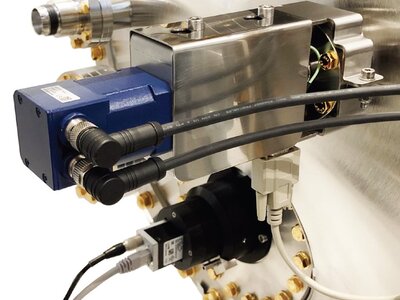HiPP-2
Photoelectron Spectroscopy at Ambient Pressures and High Kinetic Energies
- Up to 50 mbar N2 / 20 mbar H2O at sample position using standard cone
- Energy range up to 10 000 eV with full angular acceptance
- Refocusing pre-lens with efficient differential pumping
- Angular acceptance: 26°
- Angular resolved range: 22°
The Scienta Omicron HiPP-2 analyser is developed for high pressure photoelectron spectroscopy (APPES) and hard X-ray photoelectron spectroscopy (HAXPES). This state-of–the-art analysis tool enables angle-resolved photoemission at ambient pressures up to 50 mbar and kinetic energies up to 10 keV, as well as the combination of the two.
The HiPP-2 analyser is based on the Scienta Omicron 10 keV analyser and developed to allow for high pressures at the sample position. This is achieved by the addition of a pre-lens that combines efficient differential pumping with electron optics, which refocuses the electron paths through the pre-lens resulting in a high transmission analyer. The pre-lens is equipped with a front cone with a small aperture that permits electrons to enter the analyser while providing efficient differential pumping. The front cone angle is 45 degrees, which allows easy access for photon sources, other equipment, and sample handling. The front cone can be interchanged in order to increase or decrease the aperture and thereby optimise the transmission vs. maximum pressure of the experiment. Truncated front cones are available, to allow for increased working distance when performing UHV- or liquid jet experiments. The front cone can furthermore be customised to allow for user-specific designs.
More Information
Unique Pre-lens Design
The analyser contains four differential pumping zones to enable efficient pumping. In spite of this, the novel refocusing design of the pre-lens enables an angular resolved range of 22 degrees, as well as a maximum angular acceptance of 26 degrees. The angular mode enables not only band structure investigations, but also XPS depth profiling and x-ray photoelectron diffraction (XPD). The extended angular range of the analyser is made possible by the use of a novel mesh-based design of the pre-lens.
Hipp-2 Pre-lens
The pre-lens is equipped with a front cone with a small aperture that permits electrons to enter the analyser while providing efficient differential pumping. The front cone angle is 45 degrees, which allows easy access for photon sources, other equipment, and sample handling. The front cone can be interchanged in order to increase or decrease the aperture and thereby optimise the transmission vs. maximum pressure of the experiment. Truncated front cones are available, to allow for increased working distance when performing UHV experiments. The front cone can furthermore be customised to allow for user-specific designs, e.g. gas cells.
Novel Research Areas
While photoemission traditionally have been limited to ultra-high vacuum (UHV) conditions, the possibility to perform experiments under ambient pressure conditions opens up for completely new directions of science. Research topics that become possible include studies of liquids, gaseous samples and aerosols, as well as studies of catalysis under near-working conditions. Furthermore, the combination of ambient pressure and HAXPES enables studies of buried interface and bulk properties of complex samples including fuel cells. The long electron inelastic mean free path characteristic of the HAXPES regime enables detailed studies of liquid/solid and liquid/liquid interfaces, including chemical information. The HiPP-2 instrument introduces photoemission as an attractive tool for a wide range of research areas, including wet chemistry, atmospheric physics/chemistry and biology.
Specifications
< 15 meV FWHM at kinetic energy 500 eV
5 eV – 10 000 eV
± 11°
10 eV -10 000 eV
-
-
2*10-10 mbar – 50 mbar
DN200CF (10” O.D.)
For full specifications and more information about product options, please do not hesitate to contact your local sales representative.
Find the contact details here: Contact Us
Results

In-situ probing of the Fischer-Tropsch reaction on Co single crystal surfaces up to 1 bar
The surface chemistry of the Fischer-Tropsch catalytic reaction over Co has still several unknows. Here, we report an in-situ X-ray photoelectron spectroscopy study of Co(0001) and Co(10-14), and in-situ high energy surface X-ray...
Influence of Many-Body Effects on Hole Quasiparticle Dynamics in a WS2 Monolayer
Monolayer (ML) transition metal dichalcogenides (TMDCs) emerged as ideal materials to combine spin and momentum of charge carriers for spintronics and valleytronics applications. Despite its relevance for TMDC-based technology, the...
The Structure of the Active Pd State During Catalytic Carbon Monoxide Oxidization
Using grazing incidence X-rays and X-ray photoelectron spectroscopy during the mass transfer limited catalytic oxidation of CO, the long-range surface structure of Pd(100) was investigated. Under the reaction conditions of 50:4 O2...
Downloads

HiPP-2: High Energy Ambient Pressure Electron Analyser
The Scienta Omicron HiPP-2 analyser is developed for ambient pressure photoelectron spectroscopy (HiPP or APPES) as well as hard x-ray photoelectron spectroscopy (HAXPES). This state-of–the-art analysis tool enables angle-resolved photoemission at ambient pressures up to 50 mbar and electron kinetic energies up to 10 keV, as well as the combination of the two.

Custom Made Chamber: Magnetically Shielded UHV Chambers
Quality chamber design is crucial when you need to build your experimental setup from the ground up with individual components and an established system solution is not of interest. The chamber centrally links all of the components together while providing UHV conditions and excellent magnetic shielding.




